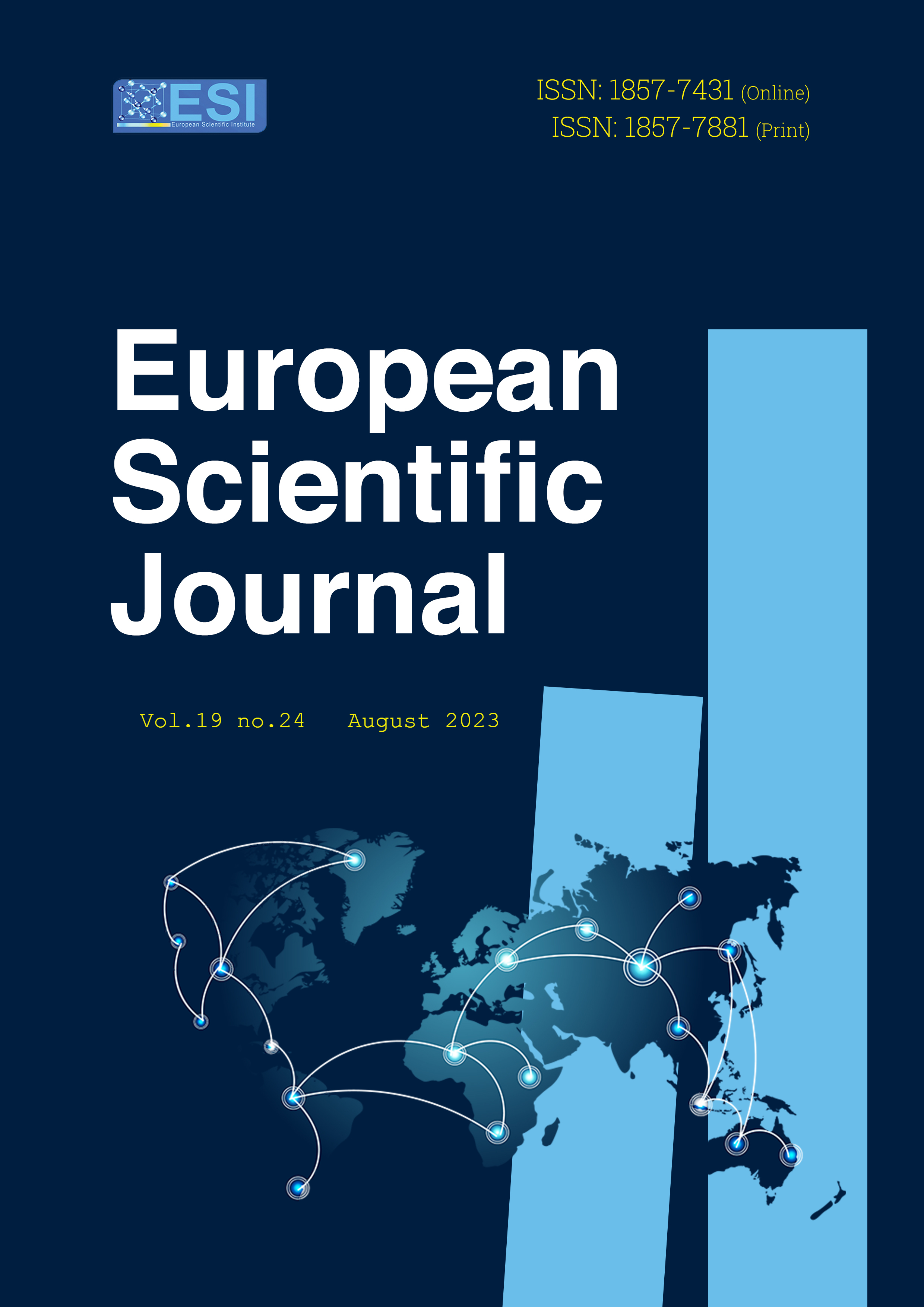First Isolation and Identification of Agriphages in Vegetable Crops in West Africa (Cȏte d’Ivorie): Potential Uses of Biocontrol in Plants
Abstract
Agriphages or bacterial viruses are ubiquitous in the environment. The discovery of virulent phages against phytobacteria improves crop growth and proposes biopesticide uses for plant diseases. In Africa, many phytobacteria such as Ralstonia, Clavibacter, and Xanthomonas were reported in several regions. This paper focuses on evaluating the presence of agriphages for the biocontrol of phytobacteria in Côte d'Ivoire. Leaves and soil samples were collected from healthy and diseased plants in three sites located in Anyama, Abidjan, and Bingerville. The pretreatments occurred with sterile and physiological water for leaves and soil samples, respectively. The isolation of agriphages was done on specific media with Xanthomonas campestris as bacterial host. Lytic activity was tested on agar media for five bacteria strains. After DNA extraction using the Qiagen method kit, molecular confirmation of agriphages was done by Random Amplified Polymorphic DNA-PCR. From this study, five (5) agriphages were isolated in soil and leaves in site 2. These agriphages have all been isolated from Xanthomonas campestris and have a broad spectrum of lytic activity. Molecular characterization by RAPD-PCR showed that three of these agriphages are DNA phages. The dendrogram showed that phages ΦXanS1 and ΦXanS2 have 93% similarities, while ΦXanS1 and ΦXanS2 are 62% similar to ΦXanF1. This study is the first reported agriphages in West Africa, alongside their potential uses against phytobacteria for biocontrol infection in crops.
Downloads
Metrics
PlumX Statistics
References
2. Adioumani, A.E., Kakou-Ngazoa, S., Trebissou, J.N.D., Martin, T., Addablah A., Koudou, A., Kouassi, K.S., Sina K. M., Coulibaly, N., Aoussi, S., & Dosso, M. (2022). Isolation and identification of phytopathogenic bacteria in vegetable crops in West Africa (Côte D’ivoire). African Journal of Microbiology Research, 16(4): 167-177. https://doi.org/10.5897/AJMR2021.9610
3. Alengebawy, A., Abdelkhalek, S.T., Qureshi, S.R., & Wang, Q.M. (2021). Heavy Metals and Pesticides Toxicity in Agricultural Soil and Plants : Ecological Risks and Human Health Implications. Toxics, 9 (42) : 1-33. https://doi.org/10.5897/AJMR2021.9610
4. Buttimer, C., McAuliffe, O., Ross, R.P., Hill, C., O’Mahony, J., & Coffey, A. (2017). Bacteriophages and bacterial plant diseases. Frontiers in Microbiology, 8: 1–15. https://doi.org/10.3389/fmicb.2017.00034
5. Djeto-Lordon, C., Alene, D.C., & Reboul, J.L. (2007). Contribution à la connaissance des insectes associés aux cultures maraichères dans les environs de Yaoundé -Caméroun. Cameroun Journal Biological and biochemical Sciences, 15 : l-13.
6. FAO. (2015). Etude sur le suivi de l’effet des pesticides sur la santé humaine et l’ environnement. Rapport de l’ONSSA,Abda, 73p.
7. Flores, O., Retamales, J., Mauricio, N., Le, M., Salinas, P., & Besoain, X. (2020). Characterization of Bacteriophages against Pseudomonas Syringae pv . Actinidiae with Potential Use as Natural Antimicrobials in Kiwifruit Plants. Microorganisms, 8. https://doi.org/10.3390/microorganisms8070974
8. Gracelin, D.H.S., Britto, A.J.D.E., Jeya, P.B., & Kumar, R. (2012). Leaves of centella asiatica collected in tamilnadu. Asian Journal of Pharmaceutical and Clinical Research, 5: 111–113.
9. Gutiérrez, D., Martín-Platero, AM., Rodríguez, A., Martínez-Bueno, M., García, P., & Martínez, B. (2011). Typing of bacteriophages by randomly amplified polymorphic DNA (RAPD)-PCR to assess genetic diversity: Bacteriophage typing by RAPD-PCR. FEMS Microbiology Letters 322(1):90‑97. doi: 10.1111/j.1574-6968.2011.02342.
10. Hatfull, GF. (2008). Bacteriophage genomics. Current Opinion in Microbiology. 11(5):447-53.
11. Jakočiūnė, D. & Moodley, A. (2018). A Rapid Bacteriophage DNA Extraction Method. Methods and Protocols 1(3):27. DOI: 10.3390/mps1030027
12. Jones, J.B., Vallad, G.E., Iriarte, F.B., Obradović, A., Wernsing, M.H., & Jackson, L.E. (2012). Considerations for using bacteriophages for plant disease control, 2: 208–214. doi: 10.4161/bact.23857
13. Jovana, D., Krier, F., & Jacques, P. (2014). Les biopesticides, compléments et alternatives aux produits phytosanitaires chimiques (synthèse bibliographique). Biotechnologie, Agronomie, Société et Environnement, 18(2): 220-232.
14. Kakou-Ngazoa, ES., Addablah, AA., Krylova, K., Saraka, D., Kouassi, KS., Coulibaly, ND., Sina, KM., Aoussi, S., Dozois, C., & Dosso, M. (2020). First novel phages from rodents with lytic activity on clinical Enterobacteriaceae strains : Initiation for phage therapy in West Africa. African Journal of Microbiology Research 14(6):280-285.
15. Kumari, S., Harjai, K,. & Chhibber, S. (2009). Characterization of Pseudomonas aeruginosa PAO Specific Bacteriophages Isolated from Sewage Samples. American Journal of Biomedical Sciences 1(2):91-102. doi: 10.5099/aj090200091
16. Koskella, B. & Meaden, S. (2013). Understanding Bacteriophage Specificity in Natural Microbial Communities. Viruses 5(3):806-823. doi: 10.3390/v5030806
17. Popoola, A. R., Ganiyu, S. A., Enikuomehin, O. A., Bodunde, J. G., Adedibu, O. B., Durosomo, H. A., & Karunwi, O.A. (2015). Isolation and Characterization of Ralstonia solanacearum Causing Bacterial Wilt of Tomato in Nigeria. Nigerian Journal of Biotechnologie, 29: 1–10. DOI: 10.4314/njb.v29i1.1
18. Qiagen (2003). QIAamp ® DNA Mini Kit and QIAamp DNA Blood Mini Kit Handbook For DNA purification from Whole blood Buffy coat Body fluids Lymphocytes Cultured cells Tissue Swabs Dried blood spots February 2003.
19. Son, B., Yun, J., Lim, J-A., Shin, H., Heu, S., & Ryu, S.(2012). Characterization of LysB4, an endolysin from the Bacillus cereus-infecting bacteriophage B4. BMC Microbiology 12(1):33. https://doi.org/10.1186/1471-2180-12-33
20. Twest, R.V. & Kropinski, A.M. (2009).Bacteriophages Enrichment from Water and soil, In Clokie MRJ & Kropinski AM (eds.). Bacteriophages: Methods and Protocols, Volume 1: Isolation, Characterization, and Interactions, Hatfield, Humana Press, «Methods in Molecular Biology,501, Pp. 15-21. Doi: 10.1007/978-1-60327-164-6_2
21. Vloek, V. & Pohanka, M. (2018). Adsorption of copper in soil and its dependence on physical and chemical properties. Acta Univ. Agric. Silvic. Mendel. Brun. 66, 219–224.
22. Wang, W.L., Moore, K., Martiny, A.C., & Primeau, F.W. (2019). Supplementary Material for Convergent Estimates of Marine Nitrogen Fixation. Nature,1-59. Doi: 10.1038/s41586-019-0911-2
23. Zaczek-Moczydłowska1, Gillian, K., Young, James, T., Colin, C., Katrina, C., & Richard, O. (2020). Genomic Characterization, Formulation and Efficacyin Planta of a Siphoviridae and Podoviridae Protection Cocktail against the Bacterial Plant Pathogens Pectobacteriumspp. Viruses(12),16p. doi: 10.3390/v12020150.
Copyright (c) 2023 Akou Emmanuella Adioumani, Solange Kakou-Ngazoa, Noel David Trebissou Jonhson, Martin Thibaut, Addabah Audrey, Koudu Aristide, Sina K. Mireille, Aoussi Serge, Dosso Mireille

This work is licensed under a Creative Commons Attribution 4.0 International License.








